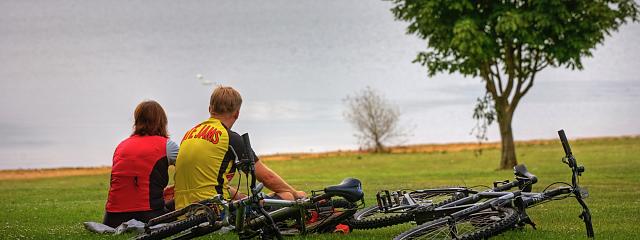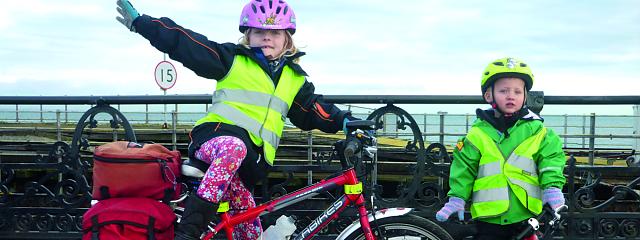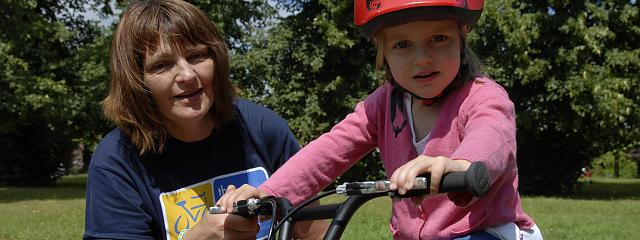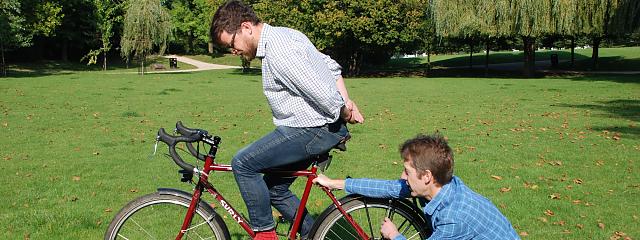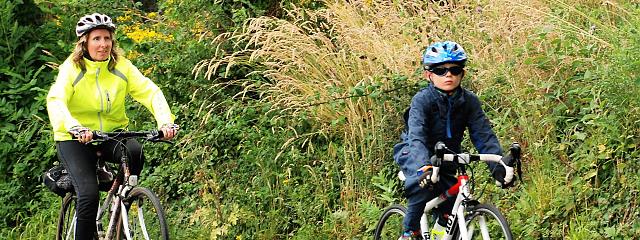
How to encourage family and friends to start cycling
How to encourage family and friends to start cycling
Over the years, as a cycling instructor I have taught many people to cycle. There is no one way to make someone love cycling as much as you do, but by taking things slowly, giving the right encouragement, you are more likely to succeed in at least making it a fun, healthy activity you can do together, whatever their age or ability.
My two children are both adults now and commute to work and university by bike. They realise it’s a practical, cheap and easy way to get around. They didn’t always love it, however – mainly when it was too cold or we went too far – but we always encouraged them to cycle as children and taught them as soon as possible how to ride a bike.
As a family, we always went to Cycling UK’s annual New Forest Cycling Week, where the kids could meet other cycling families and ride around to their hearts’ content. We also took them on holiday to the Netherlands with another family when quite young – the traffic-free routes meant they could ride their own bikes and shoot on ahead without constant supervision.
They went through their early years cycling to school, first accompanied by one of their parents then later riding to secondary school a few miles away on their own. By this time, my son was becoming passionate about dirt jumping and downhill mountain biking so riding to school was a chance to show off his ‘cool’ bikes and handling skills, as well as bond with other boys who liked the same things.
My daughter, on the other hand, went through a phase of not wanting to ride a bike for fear of looking different to her peer group. We could occasionally prevail upon her to come out on a mountain bike to places such as Bike Park Wales or the Surrey Hills, though.
Now 21, she has a cool retro bike and recognises the convenience and affordability of being able to cycle between the town and uni. She has even converted some of her friends to it, rather than them relying on the expensive local buses and trains.
But what if your nearest and dearest have never really taken to cycling? How is it best to go about encouraging them to give it a go?
It’s their decision
First of all, let them make the decision whether or not to give it a try. There are many reasons why people feel nervous about cycling, whether it’s a childhood crash, unsupportive or critical parents, memories of a painful saddle or a fear of making a fool of themselves. So recognise that it’s quite a big deal for many people, even though we use the expression ‘it’s as easy as riding a bike’.
Be patient, and if they express an interest in giving it a go, start off somewhere quiet away from traffic or curious eyes. We recommend contacting a local cycle instructor if they don’t know how to ride at all, haven't ridden for a long time or simply lack confidence – it’s often not ideal being taught by someone who is too close to you or who may not know the best techniques themselves.
Go through the basics
It might be true that you don’t forget the basics of balancing (head up, looking ahead with arms relaxed and back straight). But anyone who hasn’t ridden since childhood, might need a refresher on some of the essentials.
These might include how to use the brakes correctly (both at the same time and gently), how to set off pedalling (with one pedal in the 2 o'clock position and one leg firmly planted on the ground), and even what clothes are most suitable (loose fitting layers that won’t get caught on the chain, strong flat shoes as a minimum and, ideally, a pair of padded gloves as well).
Make them as comfortable as you can
Make the bike itself comfortable as possible to ride. Check that they can reach the brake levers easily, sit on the saddle with both feet reaching the ground and, most importantly, position their rear towards the back of the saddle, which helps with balance, and should also be more comfortable.
If they experience any discomfort, try adjusting the saddle position forward or backwards or up or down slightly. Ultimately, they might need a different bike or saddle or to add extra layers of clothing such as padded shorts.
If the person in question has never ridden a bike before, or hasn’t done so for a long time, take a look at Cycling UK’s How to teach an adult to ride a bike video or contact a local cycle instructor.
Learning without stress is the key to becoming a confident cyclist and you’ll be amazed how quickly this can be achieved under the right conditions
Julie Rand, National Standard cycle instructor
Go for a short, traffic-free and gentle ride
The next stage is to actually go for a ride. This should be as free of traffic as possible and not involve lots of hills or other off-putting obstacles.
A distance of even a mile or two might be quite a lot for some people so keep it short and don’t go out if it’s likely to be cold or wet. You don’t want to put them off cycling before they’ve got started!
Remember how long it took you before you could achieve a distance of 20 miles or more when you first started riding? Don’t expect your newbie to take to cycling straight away, no matter how eager you are to share your favourite pastime with your loved one.
Patience is needed to overcome any nerves or lack of fitness. Learning without stress is key to becoming a confident, regular cyclist, and you’ll be amazed how quickly this can be achieved under the right conditions.
Don’t put them off
What puts newbies off continuing with cycling? Here are a few possibilities:
- I’ve witnessed versions of the following scenario many times: a man waiting for his girlfriend at BikePark Wales trail centre – she’d got left behind tackling a blue run, which is actually quite tricky. He explained he’d taken her to Swinley Forest first to get the “hang of mountain biking” but it was only her second time giving it a go.
The quickest way to put off a beginner is taking them too far or over too hard terrain early on. Build up their confidence slowly with short rides in areas that are not too busy or filled with expert cyclists bombing around in full-on Lycra, padding and body armour – what could be more intimidating to a novice rider!? - Going too long without stopping – frequent breaks for comfort stops, food and drink are vital part of enjoying the experience.
- Not waiting for the new cyclist at junctions or at the top of a climb – ideally don't include much climbing for the first few rides if possible. The fear of embarrassment because they can’t keep up puts many people off riding with others. Reassure your partner/sibling/child/friend that you will wait for them.
- Even better, ride a little bit behind them and slightly out to the right to protect them from following traffic and so you can keep a good eye on what they're doing – this is especially important if they are children or new cyclists. Plus they don’t feel like they are constantly playing catch up, with the only view that of your disappearing rear end. We have a complete guide to how to ride on roads with children that’s well worth reading.
- When you stop for a break, don’t set off again as soon as they have caught up – they’ll need a breather too! Nothing is more dispiriting than finally reaching the group of other riders, gasping for a drink, only to find they’re off again.
- Don’t patronise them by saying things like “you’re doing really well for a beginner”, or worse, by constantly criticising their technique, their choice of clothing, their bike, the route and so on. They may want to wear high heels and ride an old bone shaker and if that’s what they feel comfortable doing, let them.
Your choices may be different, but that doesn’t necessarily make them right for others. You might want to subtly suggest more suitable alternatives, though. - Don’t bore them with lots of technical talk, unless they are that way inclined. Your fascination with tyre sizes, relative gear ratios and carbon fibre versus titanium might be thrilling to you but for others, slightly less so.
How to help keep new riders interested
- Visit places of interest so they forget about the cycling and concentrate on the whole experience of travelling somewhere under their own steam.
- Nothing is more demoralising than the lack of a reward for all that effort, so check beforehand that places are open and be sure to carry your own food and drink supplies in any case.
- Emphasise the great health benefits of cycling – those hills might be demanding but they’re doing you the power of good – plus you get to enjoy coming down the other side!
- Try out different kinds of riding: somebody who hates cycling in traffic might be OK off road or on traffic-free paths; you can plan a quite route using our Journey Planner. Or you could try riding later or earlier in the day, especially when there’s lots of summer daylight.
- Buddy up with other cycling returnees or newcomers. Many groups such as Sofa to Saddle, Cycle Bristol and Portsmouth CTC have graded challenges, which give riders something to aim for as the rides get progressively longer up to a certain distance. The sense of satisfaction as each stage is achieved is a great motivator, as long as you keep the targets within the person’s ability level.
Hopefully, a new long-term cyclist will be born after a few rides. Once they are, don’t forget to ask them to join Cycling UK and enjoy the benefits of being a member, such as riding with our local groups, third party insurance and receiving discounts at retailers such as Cotswold Outdoor and bike shops.







